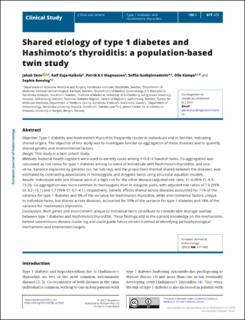| dc.contributor.author | Skov, Jakob | |
| dc.contributor.author | Kuja-Halkola, Ralf | |
| dc.contributor.author | Magnusson, Patrik K.E. | |
| dc.contributor.author | Gudbjörnsdottir, Soffia | |
| dc.contributor.author | Kämpe, Olle | |
| dc.contributor.author | Bensing, Sophie | |
| dc.date.accessioned | 2022-09-27T12:12:37Z | |
| dc.date.available | 2022-09-27T12:12:37Z | |
| dc.date.created | 2022-09-20T13:33:04Z | |
| dc.date.issued | 2022 | |
| dc.identifier.issn | 0804-4643 | |
| dc.identifier.uri | https://hdl.handle.net/11250/3021794 | |
| dc.description.abstract | Objective
Type 1 diabetes and Hashimoto’s thyroiditis frequently cluster in individuals and in families, indicating shared origins. The objective of this study was to investigate familial co-aggregation of these diseases and to quantify shared genetic and environmental factors.
Design
This study is a twin cohort study.
Methods
National health registers were used to identify cases among 110 814 Swedish twins. Co-aggregation was calculated as risk ratios for type 1 diabetes among co-twins of individuals with Hashimoto’s thyroiditis, and vice-versa. Variance explained by genetics (i.e. heritability), and the proportions thereof shared between the diseases, was estimated by contrasting associations in monozygotic and dizygotic twins using structural equation models.
Results
Individuals with one disease were at a high risk for the other disease (adjusted risk ratio: 11.4 (95% CI: 8.5–15.3)). Co-aggregation was more common in monozygotic than in dizygotic pairs, with adjusted risk ratios of 7.0 (95% CI: 3.2–15.1) and 1.7 (95% CI: 0.7–4.1), respectively. Genetic effects shared across diseases accounted for 11% of the variance for type 1 diabetes and 9% of the variance for Hashimoto’s thyroiditis, while environmental factors unique to individual twins, but shared across diseases, accounted for 10% of the variance for type 1 diabetes and 18% of the variance for Hashimoto’s thyroiditis.
Conclusions
Both genes and environment unique to individual twins contribute to considerable etiologic overlap between type 1 diabetes and Hashimoto’s thyroiditis. These findings add to the current knowledge on the mechanisms behind autoimmune disease clustering and could guide future research aimed at identifying pathophysiological mechanisms and intervention targets. | en_US |
| dc.language.iso | eng | en_US |
| dc.publisher | BioScientifica | en_US |
| dc.rights | Navngivelse 4.0 Internasjonal | * |
| dc.rights.uri | http://creativecommons.org/licenses/by/4.0/deed.no | * |
| dc.title | Shared etiology of type 1 diabetes and Hashimoto’s thyroiditis: a population-based twin study | en_US |
| dc.type | Journal article | en_US |
| dc.type | Peer reviewed | en_US |
| dc.description.version | publishedVersion | en_US |
| dc.rights.holder | Copyright 2022 The Authors | en_US |
| cristin.ispublished | true | |
| cristin.fulltext | original | |
| cristin.qualitycode | 2 | |
| dc.identifier.doi | 10.1530/EJE-22-0025 | |
| dc.identifier.cristin | 2053549 | |
| dc.source.journal | European Journal of Endocrinology (EJE) | en_US |
| dc.source.pagenumber | 677-685 | en_US |
| dc.identifier.citation | European Journal of Endocrinology. 2022, 186 (6), 677-685. | en_US |
| dc.source.volume | 186 | en_US |
| dc.source.issue | 6 | en_US |

